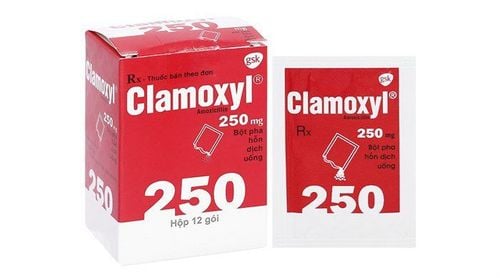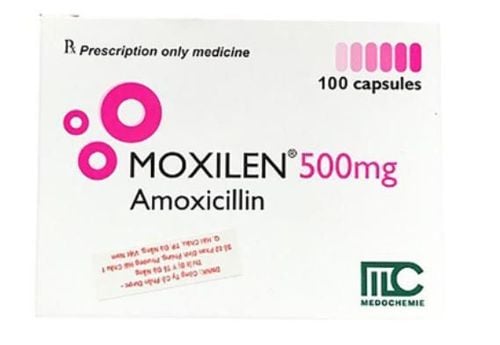This is an automatically translated article.
Amoxicillin is a penicillin antibiotic widely used in infections caused by susceptible bacteria. This antibiotic is present in the drug Augclamox 1g. So how is Augclamox 1g indicated?
1. What is Augclamox 1g?
Augclamox 1g is an antibiotic with ingredients Amoxicillin 875mg combined with Clavulanic Acid 125mg. This product is exported by Ha Tay Pharmaceutical Joint Stock Company, circulated in Vietnam with registration number VD-20436-14.
Amoxicillin antibiotic in Augclamox 1g is essentially an Amino-penicillin, stable in acidic environment with a broader antibacterial spectrum than Benzylpenicillin, of which the most special ability is against gram-negative bacilli. Like other penicillins, Amoxicillin's action is bactericidal through inhibition of bacterial cell wall mucopeptide biosynthesis.
Augclamox medicine 1g is prepared in the form of film-coated tablets, packing specifications for each box of 2 blisters x 5 tablets.
2. What are the effects of Augclamox 1g?
Augclamox 1g is active against most strains of gram-negative and gram-positive bacteria such as:
Streptococcus, non-penicillinase-producing staphylococci; H. influenzae ; Diplococcus pneumoniae; N.gonorrhoeae; E.coli ; Proteus mirabilis. However, Amoxicillin is not effective against penicillinase-producing bacteria, especially methicillin-resistant staphylococci, Pseudomonas, most strains of Klebsiella and Enterobacter.
3. Indications and contraindications of Augclamox 1g
Augclamox 1g is indicated for use in the following cases:
Treatment of infections caused by strains of bacteria that are susceptible to Amoxicillin, including: Upper respiratory tract infections (including ear, nose and throat infections) such as: tonsillitis , sinusitis, otitis media; Lower respiratory tract infections, including exacerbations of chronic bronchitis, lobar pneumonia and bronchopneumonia; Gastrointestinal infections such as typhoid fever; Genitourinary infections such as pyelonephritis, gonorrhea, septic abortion or obstetric infection; It should be noted that severe infections such as sepsis, endocarditis, and meningitis caused by bacteria that are sensitive to Amoxicillin should be initiated with a high-dose parenteral preparation and should be combined with an additional antibiotic group. other births; Endocarditis Prophylaxis: Augclamox 1g can be used for the prevention of bacteremia that can develop into endocarditis. Contraindications to using Augclamox 1g :
People with a history of hypersensitivity to Amoxicillin, beta-lactam antibiotics (including Penicillin and Cephalosporin).
4. Instructions for using Augclamox 1g
4.1. How to take Augclamox 1g The patient should refer to the instructions on how to use the included Augclamox 1g. This product is in the form of film-coated tablets, so it is only taken orally, and the patient absolutely does not change the route of administration on his own.
4.2. Dosage The dosage of Augclamox 1g depends on the age, weight, kidney function of the patient and the severity of the infection as well as the susceptibility of the causative bacteria, specifically as follows:
People Adults and children over 40kg: Total daily dose of Amoxicillin from 750mg to 3g, divided into several uses; Children under 40kg: The recommended dose is 20-50mg/kg/day, divided into several doses; Note that for children under 6 months of age, the antibiotic Amoxicillin should be used in the form of a dropper oral suspension. 4.3. Some notes on the use of Augclamox 1g The dosage instructions for Augclamox 1g are intended for adults and are intended for oral administration. Amoxicillin prepared by other routes of administration will have different dosages and are specified in the accompanying leaflet. Therefore, patients should not arbitrarily change the dose of Augclamox 1g without consulting the doctor, pharmacist; Children's differences in pharmacokinetics and pharmacodynamics or risk of side effects... are very different from adults. In addition, children are not allowed to be included in clinical trials prior to the marketing authorization of a new drug. Therefore, it is necessary to be very careful when assigning Augclamox 1g to children; Treatment in case of emergency or overdose of Augclamox 1g : When using more than the recommended dose and having dangerous symptoms, the patient should immediately call 911 or go to the nearest local health facility. Relatives need to provide the doctor with a list of medications used and are taking every day (including prescription and over-the-counter drugs); In case of forgetting a dose in a course of treatment, the patient should take the missed dose of Augclamox 1g as soon as possible (usually 1-2 hours apart from the usual time). However, if it is almost time for the next dose to remember, skip the missed dose of Augclamox 1g and take the next dose at the scheduled time.
5. Some cautions when taking Augclamox 1g
Several serious, sometimes fatal, hypersensitivity reactions (severe anaphylaxis) have been reported in patients receiving beta-lactam antibiotics such as Augclamox 1g. Therefore, if an allergic reaction occurs, the patient should stop taking Augclamox 1g and seek suitable alternative therapies; Erythema (multiple) with lymphadenopathy (infectious mononucleosis) has been reported in patients using the antibiotic Amoxicillin. Therefore, the use of Augclamox 1g should be avoided in patients with suspected infectious mononucleosis; Prothrombin time prolongation (very rare) has been reported in patients treated with Amoxicillin. This requires patients to be closely monitored when using Augclamox 1g concurrently with anticoagulants; Augclamox 1g used in high doses requires a balance between water intake and urine output, so it is necessary to adjust the dose of Augclamox 1g for patients with renal failure (due to decreased urinary excretion); Augclamox 1g may reduce the effectiveness of oral contraceptives; Can Augclamox 1g be used for pregnant women? Similar to all other drugs, this group of people should avoid using Augclamox 1g unless prescribed by a doctor in case it is absolutely necessary and there is no other alternative therapy. The risk of harm of Augclamox 1g during pregnancy is not clear; Breastfeeding mothers can take Augclamox 1g but should also limit it because Amoxicillin can be passed to the baby through breast milk.
6. Side effects of Augclamox 1g
Adverse effects of Augclamox 1g are rare and most of them are mild and temporary, including:
Hypersensitivity reactions such as skin rash, itching, urticaria; Erythema multiforme, Stevens-Johnson syndrome, toxic epidermal necrolysis, bullous dermatitis, and acute generalized exfoliative pustulosis (AGEP). This undesirable effect is quite serious and requires discontinuation of treatment with Augclamox 1g ; Quincke's edema, anaphylactic reaction; Serum sickness and hypersensitivity vasculitis; Interstitial nephritis ; Gastrointestinal reactions such as nausea, vomiting and diarrhea; Intestinal candidiasis; Pseudomembranous colitis and hemorrhagic colitis; Similar to other beta-lactam antibiotics, Augclamox 1g can cause hepatitis and cholestatic jaundice; Presence of crystals in the urine; Transient decrease in white blood cell and platelet counts, hemolytic anemia; Prolong bleeding time and prothrombin time; Hyperactivity, dizziness and convulsions.
7. Drug interactions of Augclamox 1g
When using two or more drugs at the same time, it is common for drug interactions to occur, leading to antagonism or synergism, and Augclamox 1g is no exception. Interactions of Augclamox 1g with other drugs:
Probenecid reduces the renal tubular secretion of Amoxicillin, so when used simultaneously with Augclamox 1g may cause an increase and prolong the concentration of amoxicillin in the blood; Absorption Augclamox 1g is not affected by food in the stomach, so it can be taken before or after meals; Nifedipine increases the absorption of Amoxicillin when Augclamox 1g is co-administered; When combining Allopurinol with Augclamox 1g will increase the risk of Amoxicillin rash; Antagonistic interactions between Amoxicillin and bacteriostatic antibiotics such as Chloramphenicol and Tetracycline may occur.
8. Pharmacology and mechanism of action of Augclamox 1g
Amoxicillin in Augclamox 1g is an antibiotic of the Aminopenicillin group, with a broad antibacterial spectrum.
Pharmacokinetics:
Absorption: Augclamox 1g is stable in gastric acid, absorption is not affected by food. This preparation is rapidly and completely absorbed from the gastrointestinal tract compared to Ampicillin; Distribution: Augclamox 1g is rapidly distributed into most body fluids, except brain and cerebrospinal fluid. However, when the meninges are inflamed, Amoxicillin can diffuse into easily; Elimination: Approximately 60% of an oral dose of Augclamox 1g is excreted unchanged in the urine in 6-8 hours. The half-life is approximately 1 hour, possibly longer in neonates and the elderly. Especially in patients with renal impairment, the half-life of Augclamox 1g varies from 7-20 hours.
Please dial HOTLINE for more information or register for an appointment HERE. Download MyVinmec app to make appointments faster and to manage your bookings easily.













